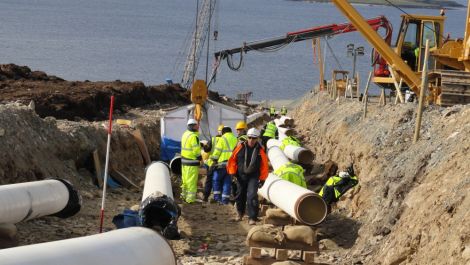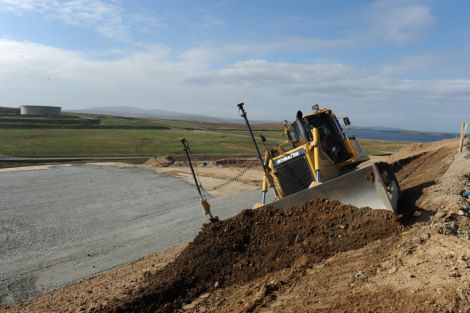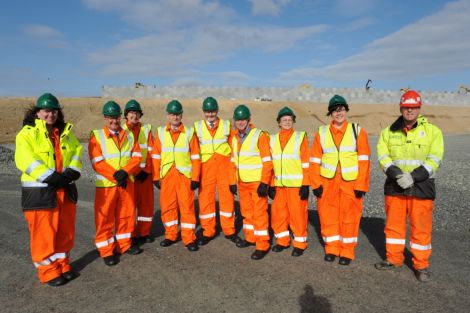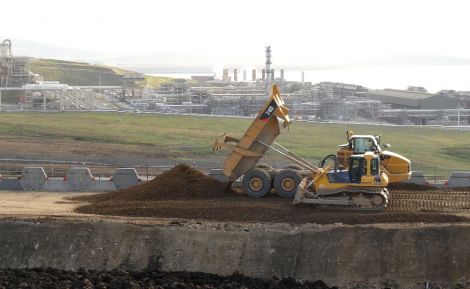News / Disturbing the peat to unlock the gas
HIDDEN from public view, construction of Total’s new £500 million Shetland gas plant is making progress as planned, and continues to be on schedule for first gas in June 2014.
On Thursday, the French oil and gas giant offered a tour of the massive building site to councillors and the local media. Just five elected members and two officials took up the invitation, however the press pack was there in full numbers.
The development at the back of the Sullom Voe Terminal presently employs 210 people, a number that will quickly rise to 800 later this year as the main contractor Petrofac moves on site to build the actual plant.
The new development is regarded as vitally important for the UK’s energy security, unlocking the “stranded gas reservoirs” to the west of Shetland by installing the infrastructure to exploit them.
The Department for Energy and Climate Change (DECC) estimates that 17 per cent of the UK’s remaining oil and gas reserves are to the west of Shetland. Total has already announced the nearby Edradour gas discovery and, after securing further blocks in the area for exploration, is confident of making further finds on the edge of the continental shelf.
At present their overall investment of £2.5 billion includes a pipeline (actually four to be precise) to be built between the Shetland gas plant and the Laggan-Tormore gas field, and a second, larger, 243 kilometre pipeline for processed gas to be pumped from Shetland to St Fergus, on the Scottish mainland.
As the pipe laying vessel Audacia disappears over the horizon laying the 143 kilometres pipeline to Laggan and Tormore at a speed of 55 metres per hour, construction workers are busy connecting the two 18 inch pipes on the gas plant site.
Project engineering interface manager Gawaine Appleby said that until around 2022, Total would use all the pipeline’s capacity for gas from Laggan-Tormore. They hope that as output from the two sister fields inevitably declines, new reservoirs in the region will feed gas into the system.
Become a member of Shetland News
He said that the pipeline currently under construction will already have four built in T-junctions to allow other operators, or Total itself, to link in.
He added that the controversial changes to the tax regime brought in by the coalition government at Westminster would not affect the work already under way, but might have an impact on any future investment decision.
“The recent tax changes that have been announced will have very little impact on this project. This project is a major investment and has already been running for 12 months. We have a target for first gas in June of 2014, and we are striving to reach that.
“The tax changes can only delay decisions that are yet to be taken on other exploration projects, which we have been hoping to tie into this system,” he said.
Back on site, Irish firm Roadbridge Construction has nearly completed the groundwork. This includes the removal of almost 700,000 cubic metres of peat, which are now being stored in two giant compounds. The plan is to reinstate the land after 30 to 50 years once the gas has run out.
The disturbance and storage of peat provokes heated debate in Shetland these days, thanks to the Viking Energy wind farm plan. As a result Total is keen to avoid the subject, other than saying they are doing all they can to store the peat in as pristine a condition as possible.
When they started, the construction site was covered in a layer of peat between one and five metres thick. The company seriously underestimated how much peat they would have to remove, initially calculating 350,000 cubic metres. Already they have extracted almost twice that amount, with one 500,000 cubic metre store already full, and a second containing 150,000 cubic metres.
The concrete clad stores consist of an earth wall several metres wide surrounding the excavated peat. Once a store is full the original turf will be spread out on top in a bid to keep it damp, and also to blend in to the landscape as much as possible.
When this work is completed in June, Petrofac will commence construction and assembly of the gas plant itself, which has been built in Kuwait and consists of 85 individual modules being shipped to Shetland bit by bit during 2012/13.
During that period Total will also build its own power station comprising of four 5.3 Megawatt liquid fuel and gas generators to power the gas plant. Initially they had hoped to tie in to the existing power plant at Sullom Voe Terminal, but negotiations with BP failed and Total opted for a “stand alone strategy”.
Mr Appleby said that so far the company had met all its targets and conditions set out in the planning consent, including completing all the pipe laying work and beach reinstatement in the Sullom Voe Special Area of Conservation (SAC) before the common seal pupping and moulting season.
“Our commitment is for first gas on 1 June 2014, and we are doing everything we can to bring that date forward,” he said.
Once operational, the Shetland gas plant will be capable of processing up to 500 million standard cubic feet of gas per day, and will employ up to 70 people.
All photos: Malcolm Younger of Millgaet Media and Hans J Marter, Shetland News.
Become a member of Shetland News
Shetland News is asking its readers to consider paying for membership to get additional perks:
- Removal of third-party ads;
- Bookmark posts to read later;
- Exclusive curated weekly newsletter;
- Hide membership messages;
- Comments open for discussion.
If you appreciate what we do and feel strongly about impartial local journalism, then please become a member of Shetland News by either making a single payment, or setting up a monthly, quarterly or yearly subscription.
































































